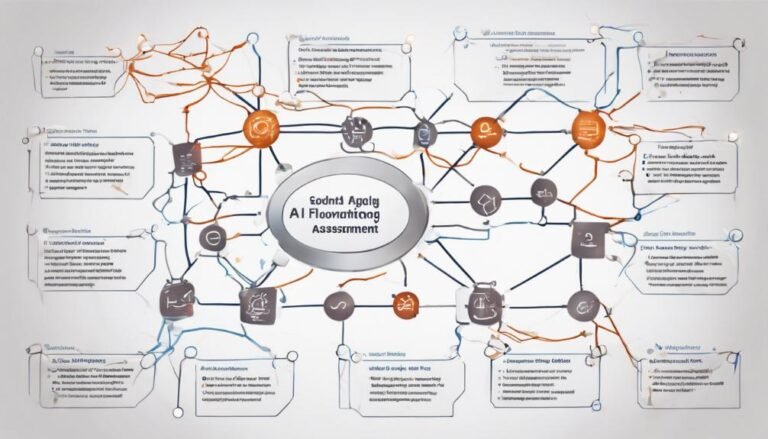AI in Financial Trend Analysis
The role of artificial intelligence (AI) in financial trend analysis has become increasingly significant in recent years, revolutionizing how market trends are understood and predicted. As AI technologies continue to advance, the capabilities of machine learning algorithms in deciphering complex financial data have raised intriguing possibilities for investors and analysts alike. The ability of AI to swiftly analyze vast amounts of data and identify patterns that may elude human analysts has sparked a new era in financial analysis. This evolution prompts an important question: how will AI further shape the future of financial trend analysis and investment strategies?
Key Takeaways
- AI integrates machine learning for accurate trend analysis.
- Predictive models use historical data for future trends.
- Real-time data analysis provides up-to-date market insights.
- Advanced algorithms enhance accuracy in trend predictions.
- AI tools revolutionize financial trend analysis with predictive analytics.
Evolution of Financial Analysis
Throughout the history of financial analysis, there has been a notable evolution in the methods and tools used to interpret market trends and make informed investment decisions. One of the key advancements in recent years has been the integration of machine learning algorithms into financial analysis processes.
Machine learning algorithms have revolutionized the way data is processed and analyzed in the financial sector, enabling traders and analysts to uncover valuable insights and patterns that were previously undetectable.
Moreover, algorithmic trading has gained significant popularity due to its ability to execute trades at high speeds and frequencies based on predefined criteria. This automated approach to trading minimizes human error and emotions, leading to more efficient and disciplined investment strategies.
Benefits of AI Integration
With the integration of AI into financial trend analysis, significant benefits have emerged that enhance decision-making processes and improve overall market performance. One of the key advantages is the enhanced accuracy AI brings to analyzing vast amounts of financial data. AI algorithms can process data with precision and consistency, reducing the margin of error in trend analysis. This increased accuracy leads to more reliable insights and predictions, aiding investors and financial professionals in making informed decisions.
Furthermore, AI integration improves efficiency by automating repetitive tasks such as data entry, data analysis, and pattern recognition. This automation allows analysts to focus their time and expertise on interpreting results and devising strategic plans based on AI-generated insights. By streamlining these processes, AI helps organizations operate more efficiently and react promptly to market changes.
Challenges in Implementation
The implementation of AI in financial trend analysis presents various challenges that organizations must navigate to harness the full potential of artificial intelligence technologies. One significant challenge is ensuring data accuracy. AI algorithms heavily rely on vast amounts of data to generate meaningful insights and predictions. Inaccurate or incomplete data can lead to flawed analysis and misguided decisions. Therefore, organizations need robust data quality processes in place to maintain the integrity of the information fed into AI systems.
Moreover, technology limitations pose another obstacle in the implementation of AI for financial trend analysis. These limitations could stem from factors such as computational power, algorithm complexity, or integration issues with existing systems. Overcoming these technological barriers requires substantial investments in infrastructure, expertise, and research. Organizations must continuously evaluate and upgrade their technology stack to keep pace with the evolving AI landscape.
AI Tools for Trend Prediction
Effective utilization of artificial intelligence (AI) tools facilitates accurate and timely trend prediction in financial analysis. AI tools leverage advanced algorithms and machine learning techniques to analyze vast amounts of data and extract meaningful insights.
Here are three key ways AI tools enhance trend prediction in financial analysis:
- Machine Learning Algorithms:
AI tools utilize sophisticated machine learning algorithms to identify patterns and relationships within financial data. These algorithms can adapt and improve their predictive capabilities over time, enhancing the accuracy of trend predictions.
- Predictive Models:
AI tools develop predictive models based on historical data, market trends, and other relevant factors. These models can forecast future trends, enabling financial analysts to make informed decisions and strategies.
- Real-Time Data Analysis:
AI tools can process and analyze real-time data streams to provide up-to-the-minute insights into market trends. This real-time analysis allows for quick adjustments to investment strategies based on the most current information available.
Future Outlook and Trends
Anticipating the future landscape of financial trend analysis requires a careful examination of emerging technologies and market dynamics. Machine learning, a subset of artificial intelligence, is poised to revolutionize the field by enabling algorithms to learn from data and make predictions without explicit programming. This technology can uncover complex patterns within financial data that may not be apparent through traditional analysis methods.
Predictive analytics, another essential tool, leverages historical information and real-time data to forecast future trends accurately. By utilizing advanced statistical algorithms and machine learning techniques, predictive analytics can provide valuable insights into market movements, enabling investors to make informed decisions.
Looking ahead, the integration of machine learning and predictive analytics is expected to enhance the accuracy and efficiency of financial trend analysis. As these technologies continue to evolve, we can anticipate more sophisticated models that can adapt to changing market conditions in real-time.
Conclusion
In the ever-evolving landscape of financial trend analysis, AI has emerged as a powerful tool revolutionizing the way market trends are understood and predicted.
By leveraging the capabilities of machine learning algorithms, analysts can explore deeper into complex data sets to uncover valuable insights and make informed decisions.
The integration of AI not only enhances efficiency but also provides a clearer vision of market dynamics, paving the way for more accurate predictions and smarter investment strategies.
The future of financial trend analysis is indeed bright with AI at its core.







